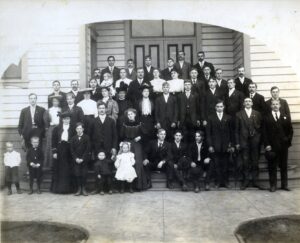Here is another fascinating look into county history left to us by the late Dr. Richard White’s “Mendocino Medicine and Gazetteer.” In the 1990s, White published this small magazine of rural health information for medical practitioners and always made space for writings about his science and nature interests. Deborah White of Ukiah loaned bound volumes of his writings to the Kelley House Museum so that we could share them thirty years later.

In the 1940 census Finns made up the largest coast ethnic group with 700 people enumerated. Group portrait of Finnish families posing at the entrance of Toveri Tupa or “Comrades Hall” in Fort Bragg, California. The hall was built by volunteer labor in 1914 and was a lively cultural center for dances, musical programs, plays, as well as meetings and public events. The building is now known as “Eagles Hall” located on Corry Street. Persons identified are: Erik Nygard, Mr. Isaac Beck, Mr. Harrison, Helen Harrison, Bill Stone, Mrs. and Edwin Black, Bill and Maude Norgard, Gus Burbeck, Edith Blank.
White discovered a 1948 master’s thesis called The “Historical Geography of Mendocino County” by Arthur Karenin from U. C. Berkeley. Karenin was born to a Finnish family at Melbourne on the Comptche-Ukiah Road. Though dated now, his work is an interesting reflection of the County seventy years ago.
The thesis covered physiography (the study of landforms), climate and vegetation, and settlement patterns of native peoples, Russians, Spaniards, and Americans. He looked at how people worked in agriculture and lumbering, but most interesting to me, he looked at our population origins. Karenin joked, “There was land – to this land came man!”
I love it when you learn something new and can say, “Gee, I never considered that before.” In a discussion on the coastal zone and the terraces that slowly rise from the ocean, the author noted that some of the lowest terraces at Fort Bragg are fifty feet tall and drop in elevation going north to Cleone, where they disappear under sand dunes. Three miles north at Ten Mile River, cliffs and terraces fifty feet tall reappear on the north bank of the river. He suggested the presence of an earthquake fault line along the river. Rapid wave erosion of soft rock terraces provide some of the sand from which the Cleone/Ten Mile dunes are made.
Because Russians established Fort Ross to the south in 1812, Spaniards were nervous about their settlement plans in this area and began establishing land grants in the southern part of the county in 1844. Americans arrived in the 1850s. White cattle ranches appeared on the Russian River, Little Lake, and Anderson Valleys. Lumbering began on the coast in 1852.
The text on agriculture described sheep and cattle grazing as the most important activity in this sector in 1948. Land cleared by logging was used for sheep grazing, especially around Albion. Land need not be flat for sheep, while cattle preferred level land. Dairying was important around Point Arena. County butter production was 375,445 pounds in 1890, most of it shipped to San Francisco.
Anderson Valley excelled in apple growing and the Ukiah and Sanel Valleys grew pears. In 1940, this country was fourth in the state in pear production. Vineyards were first planted in the 1880s and the industry “is in the hands of the Italians.” Truck crops (vegetables) were planted near large settlements or to supply cook houses in mills and logging camps. Lumbering is, of course, discussed in detail in this work.
The “Populations” section is an intriguing look at the places where people came from. Scandinavians worked in lumbering, Portuguese were fisherman, Italians worked vineyards, and Swiss milked cows. He observed “Booneville may grow somewhat, as a large mill is expected to employ several hundred men and is in the process of construction in 1948.” That growth never happened.
State of Maine people were numerous in Mendocino, Karenin’s research showed. Missouri folks were in Anderson Valley. From abroad, Italians numbered 942 in the 1940 census. They worked in the sawmills, but not in the woods where Scandinavians labored. Fort Bragg’s large Italian community was located in the southwest quarter of town.
Finns made up the largest coast ethnic group with 700 listed in the 1940 census and were located on the southeast side of Fort Bragg. In 1890 there were more than 400 Swedes in the county. Caspar had 2% of the county population but 16% of the Swedes lived there.
Danes and Norwegians settled on the coast. Englishmen (and women) were in the county at the 1870 census. That year Mendocino City had 6% of that county population, but 18% of the Irish. Mexicans were mostly non-existent in record keeping before 1948. In the 1930 census there were 130 Azorean Portuguese fisherman.
In 1890, Chinese numbered 350 working in the “culinary” field, though they performed a variety of jobs. They were early arrivals and were counted in the 1870 census. Karenin said they never turned to farming, but “China Gardens” on the south shore of Big River was where they grew produce for Mendocino City.
Graduate student Arthur Karenin went on to become a distinguished professor of geography and taught for decades. As a researcher and an author myself, I was intrigued to find his bibliography listed only 16 items. The last book I wrote, “An Eclectic History of Mendocino County,” had over 60 references. Our internet age gives access to a wealth of information I think Karenin would have loved.
Kelley House Museum’s research office is open Fridays through Sundays from 11am to 3pm. Our reference library has many special books, and the archives contain hundreds of files on coastal families, local topics, and historic houses. An appointment is best – contact [email protected] or call (707) 937-5791.